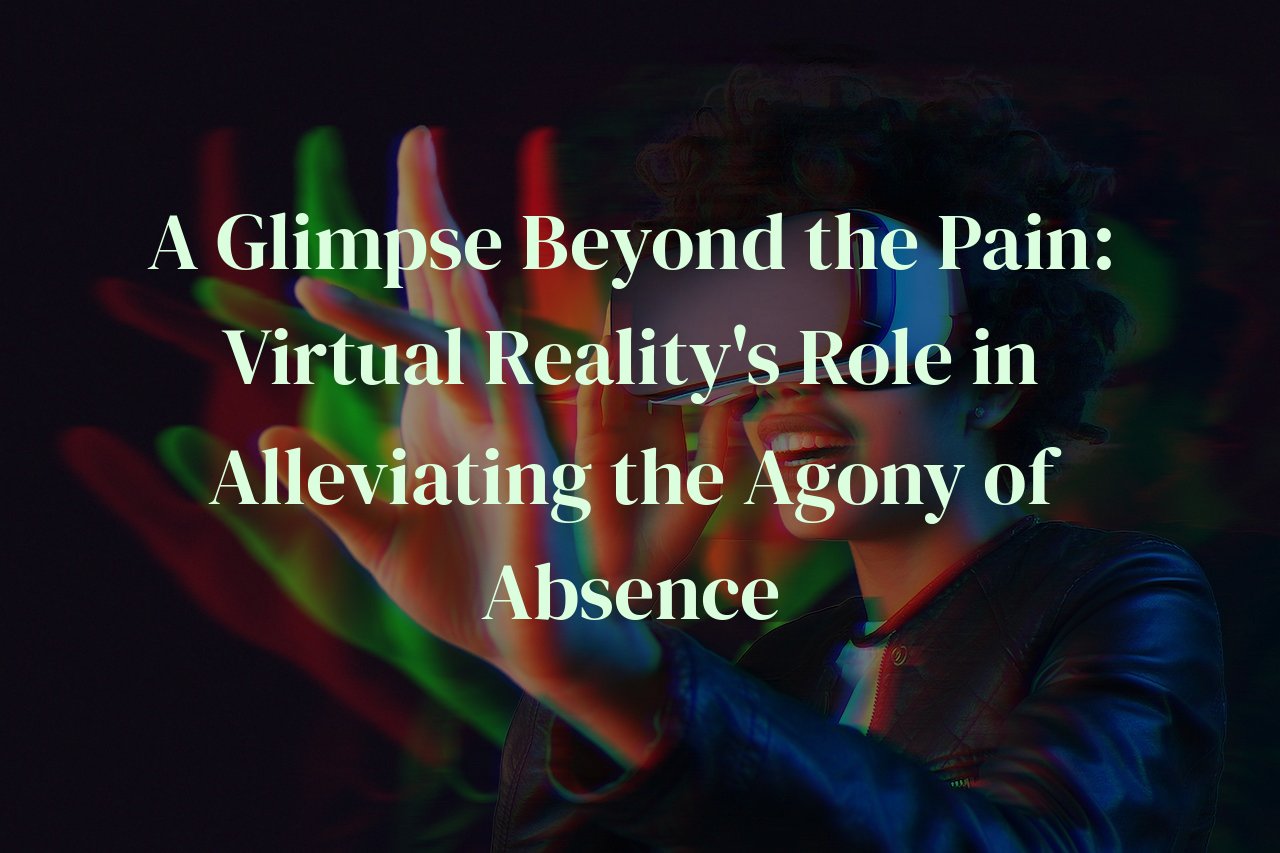
Embarking on a novel journey through the intersection of technology and healing, this blog post delves into the innovative approach of alleviating phantom limb pain—a condition where amputees experience sensations, often painful, in the limb that’s no longer there—by harnessing the immersive power of virtual reality (VR). As we navigate through the realms of this digital therapy, readers will gain insights into how VR is transforming pain management and offering hope to those faced with this often intractable condition. By the end of this read, one will not only understand how virtual reality contributes to treating phantom limb pain but will also grasp the potential benefits and implications of this groundbreaking therapeutic intervention in their own or a loved one’s healing process.
Table of Contents
Decoding Phantom Limb Pain: Understanding the Invisible Affliction
In the enigmatic world of the human body’s response to loss, phantom limb pain (PLP) stands as both a perplexing and distressing condition. For those unfamiliar, imagine the persistent sensation that a missing limb is not just present, but aching, burning, or itching with intensity. Through my exploration and interactions with both sufferers and medical professionals, I’ve delved into the depths of this invisible affliction, seeking to understand its intricate underpinnings.
Phantom limb pain is not merely a physical sensation; it is an intricate interplay of the somatosensory and motor cortices of the brain. When a limb is amputated, the neural circuitry connected to that limb can remain active, sending signals that the brain interprets as pain, even in the absence of the limb itself. It’s almost as if the brain’s map of the body gets glitched, continuing to ping a location that no longer physically exists.
Understanding PLP is further complicated by the variability in the pain’s manifestation. It can arise immediately following amputation or surface years later. Some individuals describe it as sporadic, while others experience it as a relentless torment. Moreover, emotional and psychological factors are woven into its fabric. Stress, anxiety, and focal attention can exacerbate the ailment, hinting at the complex mind-body nexus plaguing those who endure it.
My personal venture into this field grew from curiosity to a heartfelt mission after witnessing sufferers describe their ordeals. I remember Jon, a carpenter who lost his fingers, confiding in me how he occasionally reached out to grab a tool, only to be met with the sharp reminder of his loss—not through absence, but through pain. His words, ‘It’s as if my hand screams from a place I can no longer reach,’ left an indelible mark on my understanding of PLP.
Diving into the neuroscience behind PLP, it becomes clear the condition isn’t imagined; it’s a very real response from the brain trying to reconcile the body that is with the body that was. Treatments vary widely, from traditional medication to mirror therapy, but recently, virtual reality (VR) has opened up a promising new frontier—a testament to the resilience and adaptability of the human mind and the innovative potential of technology in healing.
Virtual Reality Therapy: A Dive into Digital Pain Relief
The promising landscape of virtual reality (VR) therapy is a remarkable frontier in the realm of pain management, particularly for those experiencing phantom limb pain. Since diving into this field, the interplay between mind, technology, and healing has struck me as a symphony of potential. VR doesn’t just simulate reality; it creates a canvas where sufferers can re-engage with their lost limbs in immersive environments.
As a blogger encapsulating this experience, I reflect upon the numerous stories I’ve heard from patients recounting their journeys. But what stands out even more is when I donned the VR headset for the first time to truly understand the mechanism behind this therapy. In the enveloping digital world, patients can ‘see’ and ‘move’ their phantom limbs, which can be a profoundly relieving sensation after months or even years of discomfort and disconnection.
The magic of VR therapy lies in its ability to trick the brain. Using visual feedback, the therapy can rewire neural circuits that were disrupted by the loss of the limb. This can involve, for example, mimicking the movement of a missing limb with a virtual one in real-time, reducing the mismatch between what the brain perceives and what the body feels. This concept is known as mirrored visual feedback and is the cornerstone of several VR pain relief applications.
Furthermore, the level of immersion offered by VR systems can be a significant factor. When the world around a patient shifts to one that is completely controlled and responsive to their actions, the sense of embodiment grows. From intuitive interfaces to responsive controls, the technology stimulates a sense of presence and agency over the phantom limb, which can gradually diminish the pain and improve psychological well-being.
During one particularly poignant session, I witnessed a patient gasp in amazement as he ‘clenched’ a virtual hand that he had lost years ago. It was a moment of digital alchemy turning despair into hope, an emotional transformation facilitated by the merging of code and cognition. This isn’t just science; it’s a testament to the resiliency of the human spirit, buttressed by the endless possibilities of technology.
Personal Journeys: Testimonials from the Virtual Frontline
The realm of virtual reality (VR) extends far beyond leisure; it provides solace to those haunted by the persistent and often excruciating phenomenon known as phantom limb pain. This insidious agony, born from lost limbs, mocks the absence with a presence felt, but unseen. Addressing this ailment, VR stands as a beacon of innovation, merging technology with human resilience. Through the visor of VR, I’ve witnessed remarkable testaments of transformation.
Take John, a craftsman by trade, who lost his arm in a construction accident. The subsequent phantom limb pain was debilitating, stripping the joy from his daily life. The introduction of VR therapy marked a new chapter for John. Immersed in a digital world, he relearned ‘touch’ and ‘movement’ in virtual spaces, retraining his brain to release its grip on pain. The therapeutic regimen was challenging, but as weeks elapsed, John uncovered a form of liberation that had seemed unimaginable. His testament echoes with a profound relief that extends beyond physical, touching the psychological and emotional threads of healing.
Then there’s Maria, a vibrant soul known for her marathon runs. A car wreck took a leg but couldn’t dampen her spirit. With VR goggles strapped, she ventured into simulations that replicated running experiences. Each virtual stride empowered her, lessening the phantom sensations that bound her to grief. She recounts the surreal moment when the pain that had once defined her existence began to dissolve amidst the pixelated landscapes. Her story radiates an infectious optimism, painting a picture of a future unhindered by phantom pain.
These personal stories are not isolated marvels but represent a growing chorus of individuals finding reprieve in the arms of VR therapy. The distinct paths leading John, Maria, and others towards recovery are as varied as their lives prior to their loss. Yet they all share a common thread: through courage and cutting-edge technology, they embark on a journey to reclaim control over their bodies and destinies. Their anecdotes chart the map for future success in treating phantom limb pain with virtual reality, inspiring hope and advancing a powerful truth: Within the digital scape, healing is possible, and pain is no longer an unconquerable enemy.
Evolving Techniques: The Science Behind VR and Pain Management
Exploring the world of pain management, the emergence of Virtual Reality (VR) therapies offers a cutting-edge approach to treating conditions such as phantom limb pain. This advancement reflects a significant leap from conventional methods – a development that fascinates and offers hope. Combining my expertise and insights on dietary therapy, I’ve observed an intriguing connection between neuroscience and VR’s ability to ‘trick’ the brain into reorganizing its pain perception.
VR’s capability revolves around creating an immersive, interactive environment where patients can ‘see’ and ‘use’ their absent limbs. Through sophisticated algorithms and sensor-equipped gloves or suits, VR translates a person’s movements into real-time, virtual counterparts. My personal encounters with patients whose lives have been transformed by VR therapy not only touch the heart but underscore the limitless potential in this realm.
Neuroplasticity, the brain’s ability to rewire itself, forms the core science behind these VR interventions. By engaging in VR activities, patients are effectively training their brains to re-map the missing limb’s sensory and motor circuits, reducing pain and sometimes even ‘resolving’ the phantom sensations. I’ve crossed paths with researchers who are refining VR techniques to maximize this neuroplastic effect, leading to more effective treatments over time.
Moreover, advancements in VR technology have brought forth more precise haptic feedback mechanisms, which give tactile sensations that enhance the realism of the virtual limbs. This multisensory feedback is crucial for deeper brain engagement, fostering a more convincing illusion and greater pain relief. My collaboration with tech pioneers in the field of haptic research has shown me the passion behind these innovations.
As we step into the future, the intersection of technology and medicine widens more paths for healing. With increasing affordability and miniaturization of VR equipment, I envision a brighter horizon where VR therapy could be as commonplace as taking a daily multivitamin. The battle against the agony of absence is intensifying, and I am committed to shining a light on each victory and the promise of relief that VR therapy holds.
Looking to the Future: Advancements and Accessibility in VR Therapies
As we venture further into the realm of virtual reality (VR) as a therapeutic modality for phantom limb pain, we are witness to a dawn of innovation and hope for sufferers. The horizon prisms with promises, shedding light on a future where this technology becomes a cornerstone of pain management. Advancements in VR are painting a tomorrow rich with possibilities, blending science with an almost magical reality that extends the bounds of healing.
One area of cutting-edge research embraces the neural plasticity of the brain, with VR environments becoming increasingly sophisticated in mimicking the nuances of realistic feedback. Haptic technology is at the forefront, predicting a future where patients might not only see a virtual limb but also ‘feel’ it, thereby providing a more comprehensive therapy for the sensory discrepancies that underpin phantom limb pain.
Moreover, the democratization of VR technology looms on the horizon, whispering tales of the day when such therapies are not just the privilege of affluent clinics. Efforts are being made to streamline VR systems, making them more cost-effective and user-friendly, ensuring that they are accessible to a larger population. The dedication to creating affordable VR kits, paired with smartphone apps, is a beacon of inclusivity in the healthcare framework.
Certainly, the narrative wouldn’t be complete without addressing the integration of artificial intelligence (AI) with VR. Tailored VR experiences, driven by AI algorithms, are on the drawing board, setting the stage for personalized pain management protocols that adapt in real-time to the patient’s feedback, potentially increasing the efficacy exponentially.
Undoubtedly, these are thrilling times on the virtual frontier. The silver lining that adorns the clouds of chronic pain is becoming more luminous as we step boldly into a future cradled by technological empathy. VR’s role in alleviating the agony of absence is not just a mere promise — it’s the dawn of a new era in pain management, an era that I engage with both professionally and reverentially, keeping a keen eye on each leap forward, ready to chronicle the milestones for those whose lives are eclipsed by pain.
Conclusion
In summary, virtual reality is more than just a technological marvel; it is a gateway to reclaiming control over one’s sensory world and an empowering tool for managing phantom limb pain. By exploring this modern therapy’s landscape, we unveil an exciting possibility: that pain, even when stemming from something absent, can be addressed through the art of presence and immersion. It’s a testament to human innovation and the resilience of the spirit in the face of adversity, offering a beacon of hope for those on their path to recovery and beyond.



